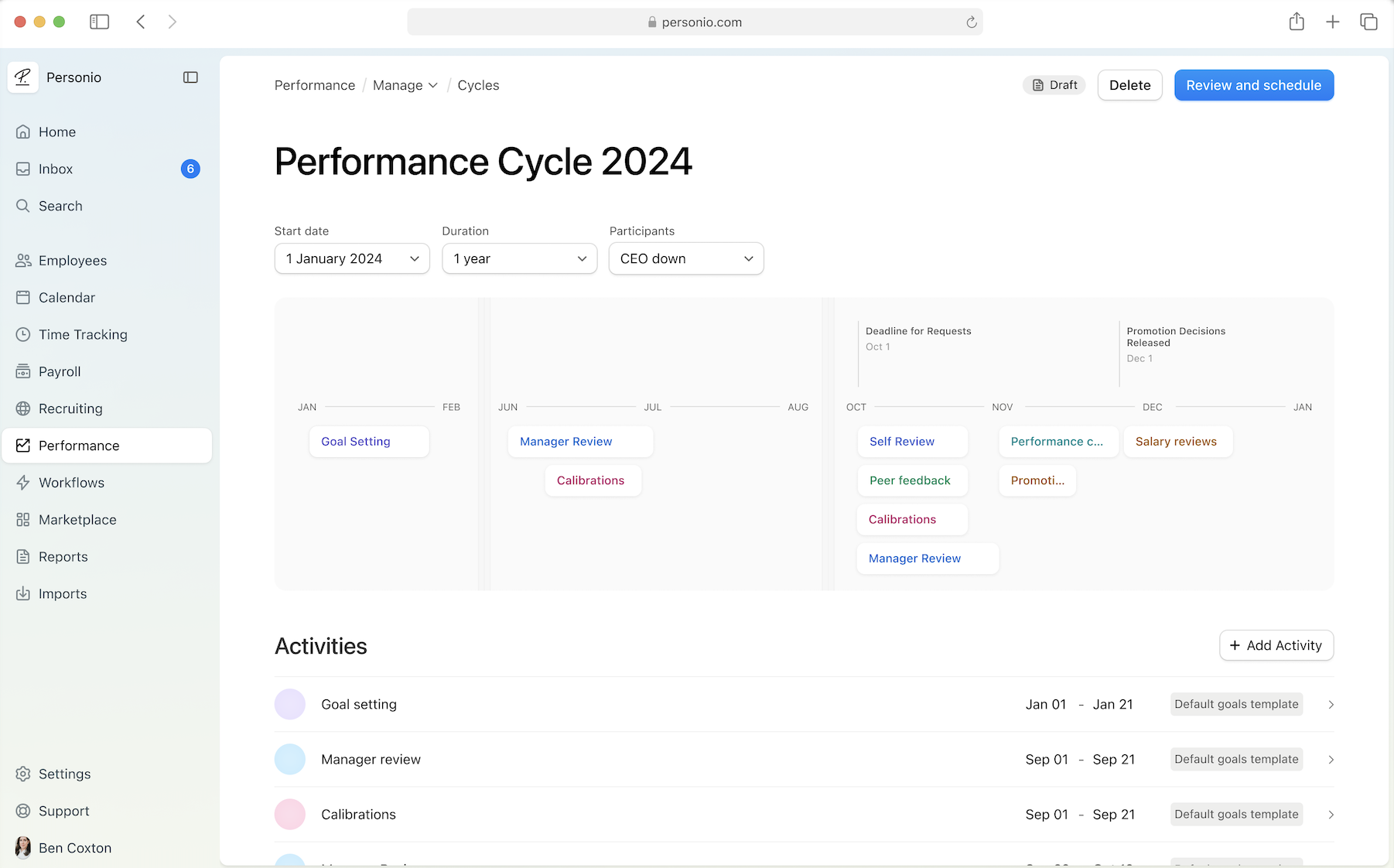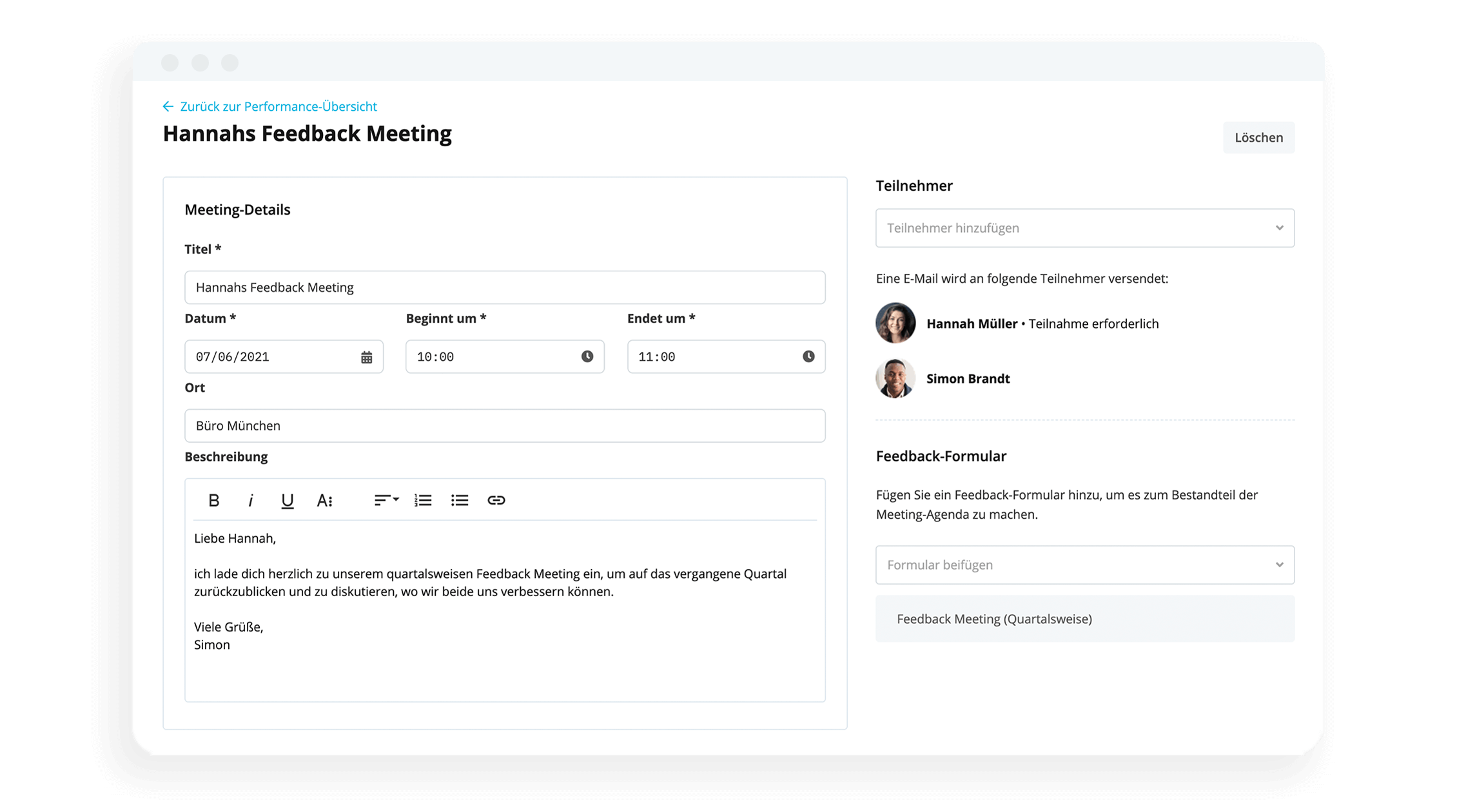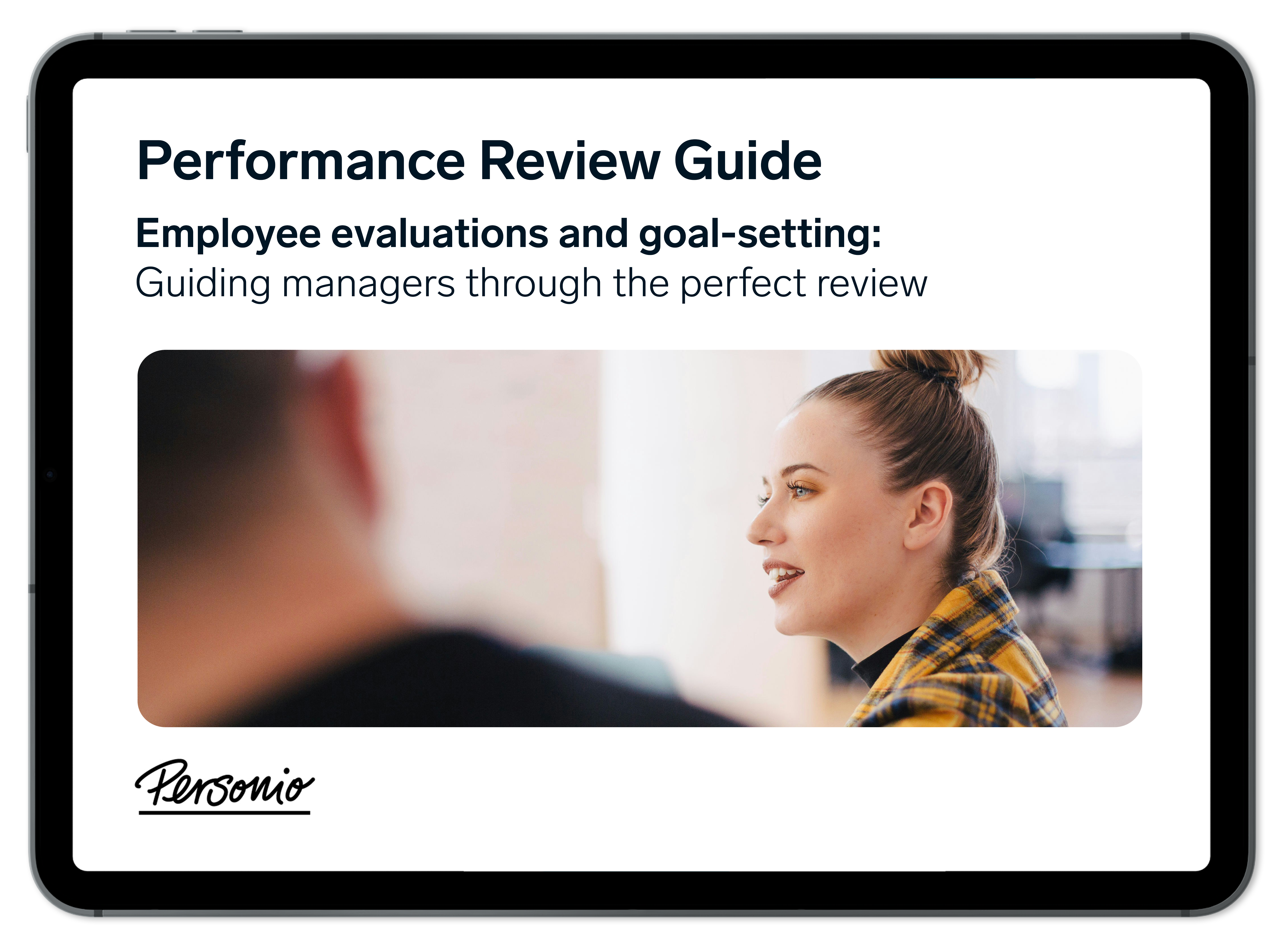
Build robust performance management processes
Personio offers customisable feedback templates, automated HR workflows and a single system to manage and track performance.
Find out more4 free performance improvement plan templates to use now

A well-crafted performance improvement plan (PIP) acts as a roadmap to success, by helping employees to get back on track and empowering them to reach their full potential. A PIP facilitates tangible employee progress by clearly outlining actionable steps to improve performance in their role and daily tasks.
In this article, we’ll describe how to create effective performance improvement plans and share four free templates to help you get started.
What is a performance improvement plan template?
If a particular employee is flagged for poor performance during the performance management cycle, they would need to participate in an improvement plan to guide them toward higher performance.
A performance improvement plan template helps employers and managers to set up and direct this process. These templates, available as downloadable PDFs or editable online documents, provide a framework for outlining specific areas of improvement, setting clear objectives, and establishing a path forward.
It’s important to note that performance reviews are complex and require tailored approaches. These PIP templates, therefore, offer guided components rather than a one-size-fits-all solution.
Nonetheless, these can be invaluable tools for managers and HR teams that facilitate constructive conversations, help track progress, and ultimately support employees in reaching their full potential.
Performance improvement plan template: What to include
Whether you’re selecting a PIP template from this list, or designing your own, make sure it includes the following elements:
Performance standards: Clearly define the expected level of performance for the employee's role. This provides a baseline for evaluating performance and identifying areas for improvement.
Identify performance issues: Identify specific instances or patterns where the employee's performance has fallen short of company expectations. Recognising areas of poor performance allows for targeted improvement efforts.
Root cause analysis: Investigate the underlying reasons contributing to the performance issues. Understanding the root causes helps in devising effective strategies for improvement.
Measurable objectives: Establish clear and measurable objectives for the employee to work towards so their progress can be tracked.
SMART goals: Develop SMART (specific, measurable, achievable, relevant, and time-bound) goals aligned with the identified objectives. SMART goals ensure that improvement efforts are focused and achievable.
Action plan: An action plan provides a structured approach to performance improvement. Outline the specific actions and steps to address performance issues and achieve the established goals.
Milestones and deadlines: Define key milestones and deadlines for achieving objectives and completing action steps. These help in monitoring progress and maintaining accountability.
Performance assessment criteria: Specify the criteria and performance metrics for evaluating progress and determining success. Clear assessment criteria ensure consistency and fairness in performance evaluations.
Support and resources: Identify any additional support, resources, or training opportunities available to assist the employee in their improvement efforts. Providing support and resources enhances the employee's chances of success in the improvement plan.
Optimise employee success

Gather feedback, automate review cycles and track important metrics in one single platform.
Find out moreWhen to use a PIP
PIPs are used when employees are underperforming but still demonstrate potential for improvement. They’re best used when clear, attainable goals can be established to help the employee get back on track.
Common issues addressed through PIPs include poor sales/results, low-quality work, chronic lateness or absences, diminished productivity, missed deadlines, and negative client or customer feedback.
However, challenges related to an employee's behaviour – like insubordination or workplace harassment – may not be effectively remedied via a PIP. These sorts of issues will be difficult to set achievable goals for, which is the basis of the PIP.
Additionally, if an employee's performance issues stem from personal challenges rather than skill deficiencies, alternatives like approved leave or increased mental health support may be more beneficial than a PIP.
To understand if a PIP is the best course of action, consider the following questions:
Is the employee's performance impacting team morale or productivity?
Has the employee's performance significantly declined or have they consistently missed targets?
Are there opportunities for improvement, and does the employee demonstrate a willingness to improve?
Is there clear evidence of performance issues that can be addressed through a structured plan?
Is the PIP merely being used as a procedural formality to justify termination?
PIPs must be tailored to individual circumstances. For example, if a previously high-performing employee experiences a sudden decline in performance, a PIP can pinpoint the underlying issue for prompt resolution. It should never be used merely as a grounds for future dismissal but rather as an opportunity for continuous improvement.

4 ready-to-use performance improvement plan templates
Here are four performance improvement plan templates designed to address various performance challenges and facilitate employee development. Each template offers a structured framework tailored to specific improvement needs.
1. Personio’s target agreement template
Personio’s performance management software allows HR professionals and managers to assess employees and encourage daily development. Our tools enable managers to set reasonable expectations, build transparency, and get a clear overview of performance with easily available data.
The target agreement template from Personio is a powerful tool for motivating and guiding your employees – while shaping their career trajectories. This template:
Facilitates collaborative goal-setting
Encourages employee development
Provides clear guidelines for future performance appraisals
This template includes employee targets, milestones, and measures to ensure that objectives are set but also quantifiable and achievable. It includes a section to define ‘goals achieved if (...),’ which is particularly valuable for qualitative targets. The template also includes achievement target dates to create a structured framework for performance improvement.
Using this template, you can define fair yet ambitious goals with your employees, and empower them to take ownership of their objectives and aspirations.

Download this template for free
2. Personio’s performance appraisal template
Our performance appraisal template provides a comprehensive framework for evaluating employee performance across various areas.
It includes an assessment of aspects like employee personality traits and development potential, working methods, overall quality of work, knowledge, insights, and soft skills. By assessing these key areas, managers gain valuable insights into employees’ strengths, areas for improvement, and growth potential.
This template is helpful when implementing a PIP as it enables managers to conduct thorough evaluations, identify areas of underperformance, and establish targeted goals for improvement.

3. Personio’s performance review template
Designed for annual or semi-annual meetings, Personio’s performance review template offers a structured approach to evaluating employee performance and encouraging professional development.
It guides managers through eight essential phases:
Establishing a productive atmosphere
Clarifying review goals
Reflecting on the review period
Appraising performance
Asking specific questions
Defining new objectives
Planning future actions, and
Ending positively
These essential phases, such as reflecting on the review period and defining new objectives, ensure performance issues are identified and addressed systematically.
Additionally, by enabling open dialogue and planning for future actions, the template encourages collaboration between managers and employees and helps build a culture of continuous improvement.
By integrating our performance review template into the PIP process, organisations can support employee growth and enhance overall performance.

Download this template for free
4. Basic performance improvement plan template
Below is a basic performance improvement plan sample that you can adapt to your specific requirements.
Provide sufficient detail to ensure that employees clearly understand what aspects of their performance need improvement, as well as the tools and resources available to facilitate that improvement. Then, set attainable goals that outline specific objectives for employees to achieve.
Employee name: [Employee's name]
Position: [Employee's position]
Date of plan: [Date]
Objective: [List specific objectives]
This performance improvement plan (PIP) outlines specific areas for improvement and establishes a clear path forward to help you reach your performance goals.
Areas requiring improvement:
[Area 1]
[Area 2]
[Area 3]
Current performance issues:
[Issue 1]
[Issue 2]
[Issue 3]
Expected performance standards:
[Standard 1]
[Standard 2]
[Standard 3]
Action plan:
1. Identify training and development needs:
Conduct a skills assessment to identify areas for improvement.
Provide relevant training sessions or workshops to address skill gaps.
2. Set clear goals and objectives:
Collaboratively establish specific, measurable, achievable, relevant, and time-bound (SMART) goals.
Regularly review progress towards these goals.
3. Provide ongoing feedback and support:
Schedule regular check-ins to provide feedback on performance.
Offer support and resources to help achieve performance targets.
4. Implement performance improvement strategies:
Develop a timeline for implementing improvement strategies.
Assign tasks and responsibilities to both the employee and supervisor.
5. Monitor progress:
Schedule regular performance evaluations to assess progress. Track progress against agreed-upon objectives.
Adjust strategies as needed based on performance outcomes and feedback.
Support resources:
List any resources, tools, or support available to improve performance.
How to create a performance improvement plan (PIP)
To facilitate a PIP, you’ll need to work through eight essential steps, each tailored to the employee's unique situation and goals.
Evaluate the situation: Determine if a PIP is the best course of action. Instead of simply being a precursor to dismissal, the decision to conduct a PIP should be based on the employee's commitment to improvement and their potential for growth.
Gain insights into performance: Review the employee's performance and gather feedback from their supervisor and team to identify areas for improvement.
Hold manager reviews: Assess the employee's training history and support from their supervisor to check if they’ve been set up for success.
Use a PIP template: Use a structured PIP template to document background information, performance deficiencies, clear goals, timelines, and consequences for non-compliance.
Have an HR review: Ensure that the proposed goals are attainable, relevant, and fair and that there is no bias against the employee.
Conduct a performance improvement plan meeting: Meet with the employee and HR representative to review the plan, encourage open dialogue, and obtain the employee's input and feedback.
Schedule employee check-ins: Regularly meet with the employee to monitor progress, provide support, and adjust the plan as needed.
Plan completion and next steps: Hold a closing meeting to review progress, celebrate achievements, set expectations for future performance, and maintain positive momentum.
By following these steps and customising the PIP to each employee's needs, organisations can effectively support employee development, address performance issues, and build a culture of continuous improvement.
Streamline performance and track progress with Personio
To successfully implement a performance improvement plan, HR teams and managers need to be able to track progress, facilitate meaningful feedback, and roll out plans for employee development.
As an all-in-one HR solution with powerful performance appraisal functionality, Personio offers a streamlined solution for building robust performance management processes. It’s never been easier to run objective assessments and encourage daily development among your team.
Ready to set your team up for success? Find out more.
